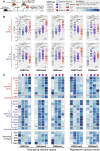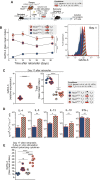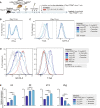Plasticity and lineage commitment of individual TH1 cells are determined by stable T-bet expression quantities
- PMID: 38838155
- PMCID: PMC11152138
- DOI: 10.1126/sciadv.adk2693
Plasticity and lineage commitment of individual TH1 cells are determined by stable T-bet expression quantities
Abstract
T helper 1 (TH1) cell identity is defined by the expression of the lineage-specifying transcription factor T-bet. Here, we examine the influence of T-bet expression heterogeneity on subset plasticity by leveraging cell sorting of distinct in vivo-differentiated TH1 cells based on their quantitative expression of T-bet and interferon-γ. Heterogeneous T-bet expression states were regulated by virus-induced type I interferons and were stably maintained even after secondary viral infection. Exposed to alternative differentiation signals, the sorted subpopulations exhibited graded levels of plasticity, particularly toward the TH2 lineage: T-bet quantities were inversely correlated with the ability to express the TH2 lineage-specifying transcription factor GATA-3 and TH2 cytokines. Reprogramed TH1 cells acquired graded mixed TH1 + TH2 phenotypes with a hybrid epigenetic landscape. Continuous presence of T-bet in differentiated TH1 cells was essential to ensure TH1 cell stability. Thus, innate cytokine signals regulate TH1 cell plasticity via an individual cell-intrinsic rheostat to enable T cell subset adaptation to subsequent challenges.
Figures








References
-
- Abbas A. K., Murphy K. M., Sher A., Functional diversity of helper T lymphocytes. Nature 383, 787–793 (1996). - PubMed
-
- M. Delbrück, Unités Biologiques Douées de Continuité Génétique, Colloques Internationaux du Centre National de la Recherche Scientifique (CNRS, 1949).
-
- Gardner T. S., Cantor C. R., Collins J. J., Construction of a genetic toggle switch in Escherichia coli. Nature 403, 339–342 (2000). - PubMed
-
- Löhning M., Richter A., Radbruch A., Cytokine memory of T helper lymphocytes. Adv. Immunol. 80, 115–181 (2002). - PubMed
-
- Monod J., Jacob F., General conclusions: Teleonomic mechanisms in cellular metabolism, growth, and differentiation. Cold Spring Harb. Symp. Quant. Biol. 26, 389–401 (1961). - PubMed
MeSH terms
Substances
LinkOut - more resources
Full Text Sources
Molecular Biology Databases

